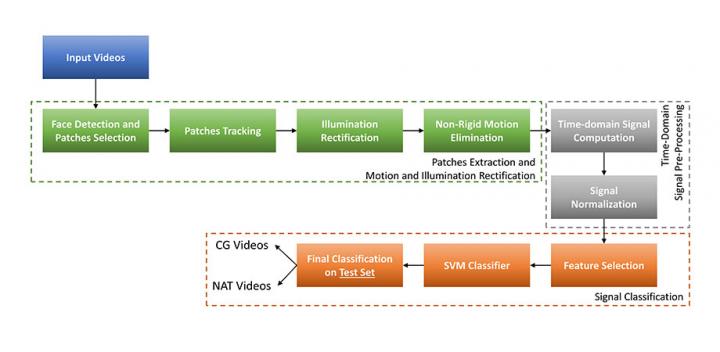Human heartbeats are the basis of the science, published in SPIE and IS&T’s Journal of Electronic Imaging

Credit: Bonomi and Boato
BELLINGHAM, Washington, USA, and CARDIFF, UK – Recent advances in computer graphics are making it possible to create computer-generated (CG) representations of human beings that are difficult to distinguish from their real-world counterparts. “Digital human face detection in video sequences via a physiological signal analysis,” a paper published today in the Journal of Electronic Imaging (JEI), presents a viable, innovative way to discern between natural humans (NAT) and CG faces within the context of multimedia forensics, using individuals’ heart rate as the discriminating feature. JEI is co-published by SPIE, the international society for optics and photonics, and by the Society for Imaging Science and Technology (IS&T).
Humans present a pulse signal that can be automatically extracted from a video sequence; virtual humans do not. In their paper, Mattia Bonomi and Giulia Boato demonstrate that by focusing on an algorithm for pulse-rate estimation from human faces and calculating statistics from that heart rate, they can classify the input face as CG or NAT.
“Recent advances in machine learning and computer graphics have led to the rapid development of deep fakes, where the face of a real person in a video is replaced by a computer generated one,” notes JEI Editor-in-Chief Karén Egiazarian. “This technology is openly available nowadays, and, together with its wide use in the movie industry and advertisements, it has been also used by fraudsters. But how to distinguish a human face from a computer generated one? Bonomi and Boato address this question by proposing and applying a physiological signal analysis, extracting the heart rate from the video of human face, and using it as a discriminating factor.”
The article authors are Mattia Bonomi and Giulia Boato, both of the University of Trento, Department of Engineering and Computer Science, Trento, Italy.
Karén Egiazarian, a professor of computing sciences at Tampere University, is the editor-in-chief of JEI. The journal is co-published digitally by the Society for Imaging Science and Technology and by SPIE in the SPIE Digital Library, which contains more than 500,000 publications from SPIE journals, proceedings, and books, with approximately 18,000 new research papers added each year.
###
About SPIE
SPIE is the international society for optics and photonics, an educational not-for-profit organization founded in 1955 to advance light-based science, engineering, and technology. The Society serves more than 255,000 constituents from 183 countries, offering conferences and their published proceedings, continuing education, books, journals, and the SPIE Digital Library. In 2019, SPIE provided more than $5 million in community support including scholarships and awards, outreach and advocacy programs, travel grants, public policy, and educational resources. http://www.
About the Society for Imaging Science and Technology
The Society for Imaging Science and Technology (IS&T) is an international professional non-profit dedicated to keeping members and other imaging professionals apprised of the latest developments in the field through conferences, educational programs, publications, and its website. IS&T programs encompass all aspects of the imaging workflow, which moves from capture (sensors, cameras) through imaging processing (image quality, color, and materialization) to hard and soft copy output (printing, displays, image permanence), and includes aspects related to human vision, such as image quality and color. The Society also focuses on a wide range of image-related applications, including security, virtual reality, machine vision, and data analysis. http://www.
Contact:
Daneet Steffens
Public Relations Manager
[email protected]
+1 360 685 5478
@SPIEtweets
Media Contact
Daneet Steffens
[email protected]
360-685-5478
Original Source
https:/
Related Journal Article
http://dx.




